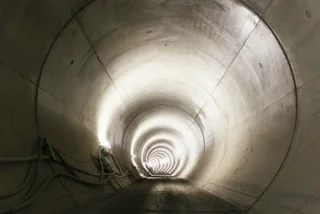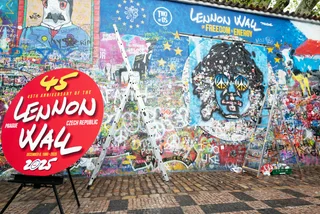Prague is filled with statues and memorials, and women are not left out. While women are the minority, Prague is still ahead of many other cities. New York's Central Park didn't get its first statue of a real woman until 2020.
Some of the names like Milada Horáková and Božena Němcová are familiar to every Czech, and even internationally. Others like Eliška Krásnohorská are a bit more obscure.
PARTNER ARTICLE
Aside from statues and plaques for famous politicians and artists, Prague also has memorials for many women who died in the Prague Uprising, for supporting Operation Anthropoid in World War II, as well as Stolpersteine to mark places where Holocaust victims lived.
Several churches and statues also commemorate Czech saints, including St. Ludmilla and St. Agnes of Bohemia (Anežka Česká). The former convent of Anežka Česká is now part of the National Gallery Prague. Both saints appear as side figures on the St. Wenceslas statue on Wenceslas Square.
Milada Horáková
Politician Milada Horáková was executed in 1950 after an infamous show trial. She opposed single-party communist rule, and was convicted of conspiracy and treason. The verdict was annuled in 1968.
A bust with her likeness can be found in Prague 4 at náměstí Pražského povstání in a small park. Prague’s Vinohrady district unveiled a plaque for her in 2022 on the apartment building where she was born. Her symbolic tomb can be found in Vyšehrad, though her ashes were scattered by communist authorities.
An abstract memorial to her other victims of oppression has been in Zahrada Ztracenka, a garden near Albertov, since 2018. There is also a rather stark statue by sculptor Olbram Zoubek at the Evangelical Church of Czech Brethren in Smíchov, and one in the form of a lark sitting on a microphone in Malá Strana near the Senate building. A street is also named after her. You can read more about her life in our previous story.






Božena Němcová
Author Božena Němcová is most remembered for her novel "The Grandmother" (Babička), which she wrote in a house on Ječná Street, and two plaques are on that building.
There is also a bronze bust of her on the site of the building on Na Příkopě Street where she passed away in 1862. The location is now a Hamley's toy store and Lidl supermarket.
A statue of her by sculptor Karel Pokorný can be found on Slovanský ostrov in front of Žofín Palace. A street is named after her, and her likeness appears on the CZK 500 banknote. You can read more about her life here.




Ema Destinnová
Opera singer Ema Destinnová (the spelling of her name varies) had an international career taking her to New York's Metropolitan Opera, London's Covent Garden, as well as Czech stages. She was the highest-paid soprano in the world, often singing with Enrico Caruso.
Her efforts to support an independent Czechoslovakia led to a premature end to her career. During World War I she was accused of crossing borders with secret messages, which led to her house arrest and her passport being revoked. She could no longer travel to perform, and even after she could travel again her career never recovered.
Her bust appears in front of Kaiserštejnský palác in Malá Strana, where she lived and had a large occult library. A plaque appears on the building where she was born on Kateřinská Street. An Asian restaurant there is named for her. She is buried in Slavín in Vyšehrad, along with other famous Czechs. Read more about her and other defiant Czech women here.



Karolina Světlá
Author Karolina Světlá, the pen name for Johanna Nepomucena Rottová, often wrote on social themes and promoted the idea that women were capable of making decisions, which was radical in the late 19th century. She is remembered for her literary realism and rural themes, as well as her relationship with writer Jan Neruda.
Her likeness can be found in Karlovo náměstí, and a plaque is on a corner next to the square, marking the location of the house where she passed away in 1899.
Another plaque on Karoliny Světlé Street, named in her honor, marks the house where she was born. She is buried in Olšany Cemeteries in a simple grave. Read more about her life here.



Eliška Krásnohorská
Eliška Krásnohorská is closely associated with Karolina Světlá, who introduced her to writing and feminism. She is best known for children's literature, but she also wrote librettos for four operas by Bedřich Smetana and one for Zdeněk Fibich.
She founded a magazine for women and established the first high school (gymnasium) for girls in the Austro-Hungarian Empire, which held lessons in Czech. Her statue is in Karlovo náměstí, across from Karolina Světlá's bust. Read about her in our look at the history of Karlovo náměstí.

Otilie Sklenářová-Mála
The most obscure person to have a statue in the city center is actress Otilie Sklenářová-Malá, next to the National Muzeum. The statue was made by Ladislav Šaloun, who also made the monument to Jan Hus in Old Town Square. Sklenářová-Malá performed at the Provisional Theatre and its successor, the National Theatre.
Later she taught opera at a school established by Bedřich Smetana and also taught drama. One of her private students was Ema Destinnová. She was also involved in early feminism, joining a group that included Karolína Světla. She died in 1910 at the age of 67 and is buried in Olšany Cemeteries. Read more about the National Theatre here.

Libuše
Statues of several legendary women can be found in Prague. The most famous is Libuše, a princess who saw a vision of the future of Prague while standing on the hill in Vyšehrad.
A statue of her and her husband, the plowman Přemyšl is in the park in Vyšehrad, though it was originally at the Palacký Bridge until just after World War II. It and other statues of mystical figures, including the female warrior Šarka were moved so the bridge's bomb damage could be repaired.
Libuše's likeness can also be found above a doorway on Karlova Street near Charles Bridge, and on several other residential buildings like one at Janáčkovo nábřeží. Murals depicting her prophecy can be found in Old Town Hall and the National Theatre, and her statue is in the entry hall to the National Museum. Read more about her and Vyšehrad here.















 Reading time: 5 minutes
Reading time: 5 minutes 




























